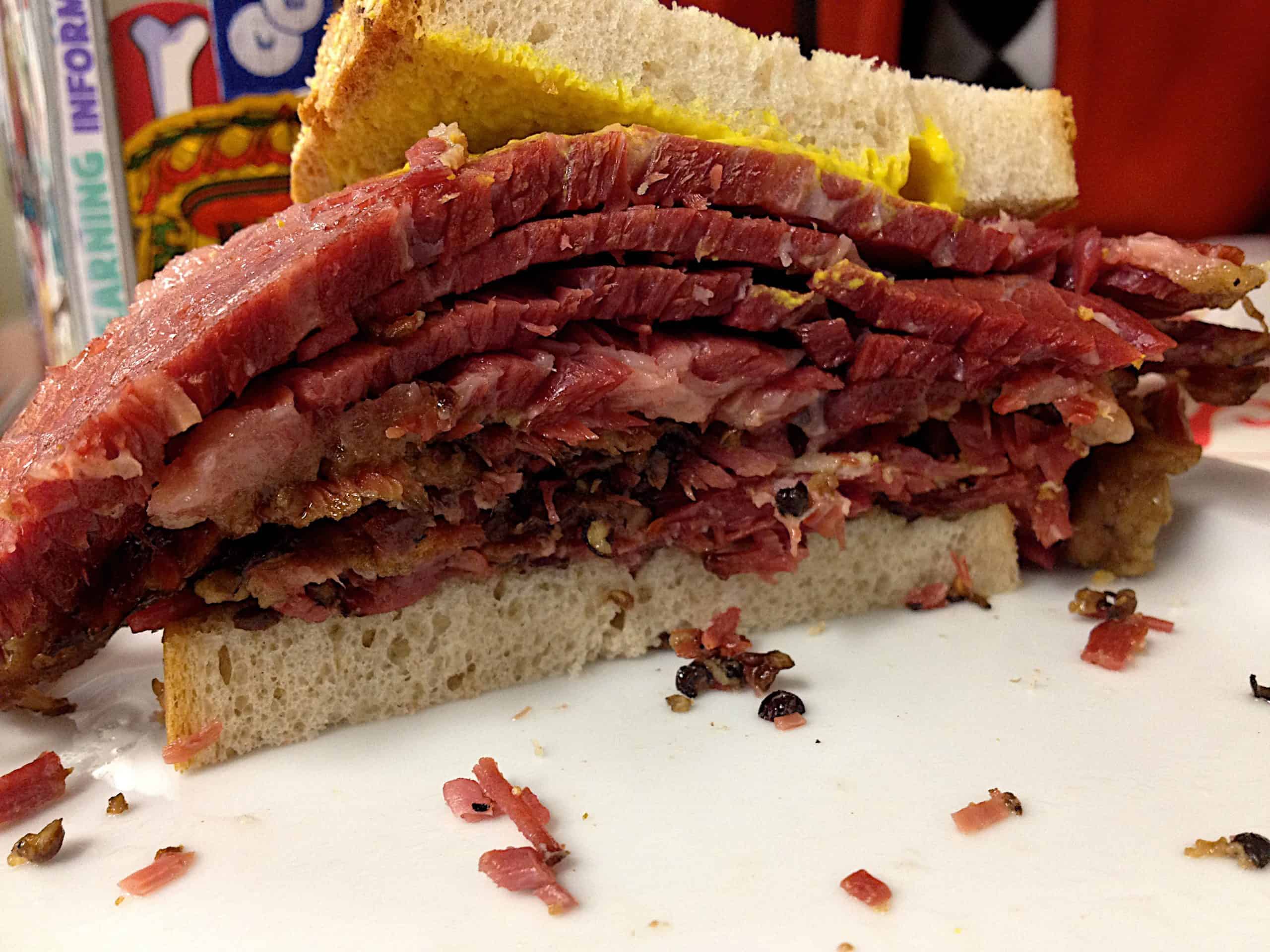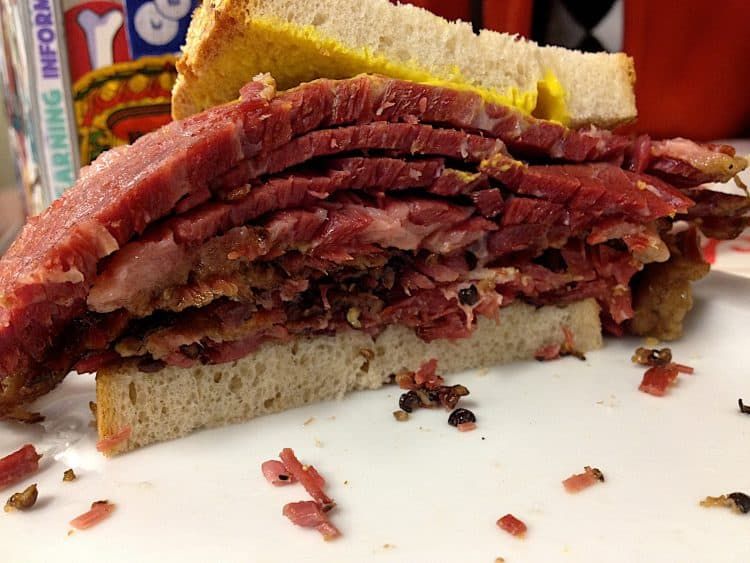Growing up in a Jewish family, the savory umami taste of salt beef brings back fond memories of holidays and celebrations. While deli-style salt beef requires serious curing and smoking skills, creating tasty homemade salt beef is actually quite simple. With minimal ingredients and easy techniques, you can make authentic Jewish salt beef to enjoy in classics like sandwiches, matzo ball soup, and more.
In this article, I’ll provide my time-tested recipe for no-fuss salt beef along with tips to ensure deli-caliber results. From choosing the right cut of meat to perfecting the simmering time, I’ll explain the entire process step-by-step. With just a bit of patience and my guidance, your brisket will transform into tender, mouthwatering salt beef worthy of any Jewish deli. So let’s get cooking!
Why Make Your Own Jewish Salt Beef?
Salt beef is a cherished staple of Ashkenazi Jewish cuisine, but high-quality premade versions can be difficult to find and expensive to buy Here are some of the benefits of making your own at home
-
Cost Savings – Buying fresh brisket and doing the salting/simmering yourself is much cheaper than purchasing pre-cured salt beef.
-
Control Ingredients – With homemade you can control exactly what goes into your salt beef without preservatives or artificial ingredients.
-
Adjust Flavor – Tailor the saltiness, spice blend, and smokiness to match your personal taste preferences.
-
Satisfaction – The rewarding experience of crafting authentic Jewish salt beef from scratch connects you with your heritage.
-
Convenience – Making a big brisket yields leftovers for quick sandwiches soups hash, and more throughout the week!
Step-By-Step Instructions for No-Fuss Jewish Salt Beef
With just a few basic steps, you can transform a brisket into amazing salt beef right in your own kitchen:
Ingredients
- 1.6 kg beef brisket
- 2 onions, quartered
- 6 cloves
- 10 peppercorns
- 4 bay leaves
- 2 Tbsp kosher salt
- Water to cover
Process
-
Place brisket in a large pot and cover with cold water by about 2 inches.
-
Add quartered onions, cloves, peppercorns, bay leaves and kosher salt.
-
Bring to a boil over high heat, then immediately reduce to a gentle simmer.
-
Simmer covered for 2-2 1/2 hours until fork-tender. Check occasionally to skim foam.
-
Remove from liquid and allow to rest 10 minutes before slicing.
And just like that, you’ll have perfect homemade Jewish salt beef ready for all your favorite dishes! The key is the long, gentle simmer which breaks down the brisket while infusing it with flavor.
Helpful Tips for Success with Homemade Jewish Salt Beef
-
Look for a first cut brisket preferably with some fat marbling for best texture and moisture.
-
Make sure brisket is fully submerged in the liquid while simmering to prevent drying out.
-
Add more water if needed during cooking to keep brisket covered.
-
Slice salt beef across the grain for maximum tenderness.
-
Refrigerate leftover salt beef in the cooking liquid for up to 5 days.
Common Questions About Creating Jewish Salt Beef
What type of meat works best for making salt beef?
For authentic Jewish-style salt beef, you want to use beef brisket. Brisket contains the right ratio of fat to lean meat and breaks down beautifully during the long simmering time.
Is it okay to use table salt instead of kosher salt?
Kosher salt is recommended since the larger grain size allows you to season the brisket evenly without over-salting. But in a pinch, you can use regular table salt, just reduce the amount to 1 Tbsp.
How can I adjust the saltiness of the finished salt beef?
Start with just 2 Tbsp of salt in the cooking liquid. Once cooked, you can taste a slice of the beef and add a pinch more salt if desired. Adding salt after allows more control over the final saltiness.
Does the brisket need to be fully submerged in liquid?
Yes, it’s important the brisket stay fully covered by at least 1-2 inches of water during the entire simmering time to absorb the flavors and cook properly without drying out.
Can I freeze leftover homemade salt beef?
Absolutely! Leftover salt beef will keep frozen for 2-3 months. Allow it to cool fully in the fridge before dividing into portions to freeze. Thaw in the fridge before using.
Serving Ideas for Delicious Homemade Jewish Salt Beef
Salt beef brisket on rye – Pile thick slices of salt beef onto toasted rye bread slathered with spicy mustard.
Matzo ball soup – Shred salt beef and add to chicken broth with matzo balls, carrots and dill.
Open faced sandwich – Top rye or challah bread with melting Swiss cheese, salt beef, and sauerkraut.
Potato hash – Fry leftover salt beef with potatoes, onions, peppers and eggs for a hearty hash.
Beef Salad – Toss shredded salt beef with lettuce, tomato, onion, cucumber, oil and vinegar.
Reuben Casserole – Layer salt beef, sauerkraut, Swiss cheese and Thousand Island dressing and bake.
The rich, savory flavors of homemade Jewish salt beef take classic recipes to the next level. Now that you know how easy it is to make at home, you’ll always have delicious salt beef ready serve up anytime – no deli required!
For more Jewish recipe inspiration, check out the [Jewish cooking] dishes shared by the Recipes.net community.

A classic brined and boiled beef recipe, synonymous with American delis.

In the United States, salt beef (or corned beef) is often found in Jewish delicatessens. It is usually a big piece of beef brisket that is brined with salt and other spices before being gently boiled.
Many different types of food around the world love salt beef. No one knows for sure where it came from, but it’s thought to have started when people started salt-curing meat to keep it fresh. Between the 17th century and the middle of the 19th century, British naval fleets and North American armies loved salt beef because it didn’t go bad. A lot of people also liked it during wartime, like the First and Second World Wars, when fresh meat was hard to come by. The canned form was the most popular in the UK. In 1943, over 16 million cans were sent from Fray Bentos in Uruguay to the UK.
They call the canned version of salt beef “corned beef” in the UK, which is a little different from the corned beef in the US. In essence, the beef is the same, but in the UK, corned beef usually means salt beef that has been minced up and mixed with a little gelatine. The word “corned beef” comes from the Old English word for small, hard particles or grains, no matter how they are different. This can mean either salt or saltpeter, which is a form of potassium nitrate that was once commonly used to keep meat fresh in salt beef recipes.
Today, sodium nitrate (or Prague Powder) is more commonly used as the key preservative. As well as lending the meat its typical pink colour, the sodium nitrate adds flavour and helps to inhibit the growth of Clostridium botulinum, which can cause botulism. If you’re averse to using sodium nitrate, however, the salt beef can be made without, but the meat will have a less appetising grey complexion and will differ from classic salt beef in terms of texture.
The salt beef is brined for five days (or less if you’re really pressed for time), then simmered for about 90 minutes per kilogram until it’s tender. It is then sliced across the grain. It tastes best with potatoes and cabbage on Christmas Day or in freshly baked bagels with mustard and lots of sharp pickles. Leftovers are also perfect in a breakfast hash.

- Container large enough for the brisket and 4.5l water
- Pestle and mortar or spice grinder
- 1.8-2 kg beef brisket trimmed and rolled
- 440 ml stout such as Guinness
- 100 g light brown sugar
- 4 tsp pink curing salt or Prague Powder #1
- 400 g fine sea salt plus more
- 1 thumb-sized piece fresh ginger peeled and sliced
- 2 dried chillies
- 1 cinnamon stick
- 8 bay leaves
- 6 cardamom pods
- 2 tbsp peppercorns
- 2 tbsp coriander seeds
- 2 tbsp mustard seeds
- 1 tbsp allspice berries
- 1 tbsp juniper berries
- 1 tsp cloves
- Put the cloves, cinnamon, bay leaves, chilies, peppercorns, coriander seeds, mustard seeds, allspice, juniper, and peppercorns in a dry pan. Toast them slowly over medium-low heat, shaking the pan every now and then. Let the spices cook for three to five minutes, or until they start to jump around in the pan and smell great. Be careful not to let them burn. Put it in a spice grinder or pestle and mortar and lightly crush it.
- Put in the ginger, stout, brown sugar, curing salt, fine sea salt, and 4 5 liters of cold water in a big pot or container that can handle food Mix until all of the sugar and salts are dissolved. Take about 125 grams of the spice mix and put it in a bowl or jar with a lid until you’re ready to cook the salt beef. Add the rest of the spices to the container with the water. Then add the brisket, making sure it’s not folded. Use a plate or something else heavy to make sure the brisket is under the water. Place a tight lid or cling film on top and brine the beef for three to five days (or less if you don’t have time). Every day, turn the beef over.
- Once the beef has been brined, take it out and give it a good rinse. Throw away the brine and heat up a large pot of lightly salted water. Put the beef and the spices you saved into the water that is simmering. Cover and cook over low heat until the beef is soft and easy to shred. It should take between 2 hours and 3 hours (9 minutes per 100g).
- Slice the beef against the grain and serve. Put the cooked salt beef in the fridge and cover it with cling film. It will last for a few days.
